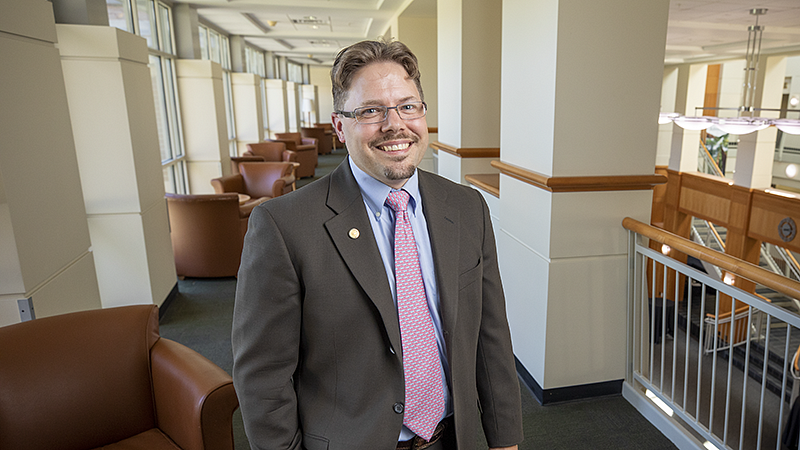When people think of law professors, they don’t automatically think of data analysis or field research.
Erik Girvan’s research investigates how stereotypes, attitudes, and other biases might impact decisions in the legal system. He empirically tests practical ways to reduce or eliminate implicit biases by working with a diverse variety of legal and other professionals.
Girvan, an associate professor at the law school, says that it is the legal perspective that makes this research more impactful as a driver of change in society.
“[Our collaborators say] if we want our research to have an impact, we need to get a lawyer or a legal academic involved, because they are going to be the one that will help translate the work into actual policy,” Girvan said.
Girvan, who earned his JD at Harvard Law School and his PhD in psychology at the University of Minnesota, teaches courses on civil litigation and conflict resolution. He is also faculty director of UO’s Conflict and Dispute Resolution Center.
Girvan says that one of the main reasons he became interested in this research was because he wanted to know whether the legal system positively and negatively affects behavior. He also wanted to determine how to help the law do a better job of doing what it's supposed to do.
“One perspective of the legal system is that it is one of the largest interventions we have to try to move behavior in a way that we as society want it,” Girvan said.
He says that as an academic, the idea of “behavioral realism,” which is the idea that the law is based on assumptions about why people behave how they do and what changes behavior, has intrigued him since college. And it has become the foundation of his research over the last 10 years.
“If you look at my research record, I do empirical work around behavioral assumptions in the law to determine if that is how things are really working,” Girvan said. “And then I take the results of that back to the law to suggest, or design and test, policy reform or changes.”
Collaboration is key
When Girvan first arrived to the UO, he says that one of the first things that he did was to seek out collaborators from other departments who had real-world data and an interest in addressing real-world problems.
After pitching his research at a faculty meeting at the UO’s College of Education, Girvan says a strong collaboration has developed over the years with various faculty members and research centers. “My partnership with education in a sense is somewhat serendipitous,” Girvan said. “They are ranked among the best education programs in the nation – and they have great researchers.”
Girvan says that he enjoyed the interdisciplinary collaboration that came through a recent study with the Professor and Philip H. Knight Chair Kent McIntosh and Postdoctoral Scholar Maria Santiago-Rosario from the College of Education. The study was supported by the Office of Special Education Programs of the US Department of Education.
Leading the team as principal investigator, Girvan along with McIntosh, and Santiago-Rosario analyzed discipline records for 1,354,010 students enrolled in 2,100 U.S. schools in 183 communities distributed across the US.
Evaluation of Oregon’s Measure 110
Most recently, Girvan’s research was used to formulate an evaluation of the state of Oregon’s Measure 110, which decriminalizes drug use and provides addiction treatment for those in possession of drugs. Girvan developed a way to measure the impact of policy changes on racial disparities, called Raw Differential Representation (RDR). As he argues in the paper, Tail, Tusk, and Trunk: An Examination of What Different Metrics Reveal about Racial Disproportionality in School Discipline, RDR can be a more useful alternative way to measure racial disparities because it provides information on the practical effect of the change.
Prior to the passage of the Measure 110, the Oregon legislative body requested racial and ethnic impact statements from the Oregon Criminal Justice Commission (CJC). And the CJC turned to Girvan’s research. In using his RDR metric, the CJC estimated that racial disparities for misdemeanor and felony possession of controlled substances convictions would be narrowed substantially with the passage of the measure.
Jen Reynolds, associate dean of faculty research and programs says that the impact of Girvan’s research will have lasting effect on the criminal justice system in Oregon – and that it has national implications.
“Erik’s work is a great example of how legal scholarship can have a real-world impact,” Reynolds said. “Last November, Oregon became the first state to take pass this type of law, thanks in part to Erik’s scholarship. Now, other states will be able to use his research as a model when considering similar legislation.”
The culminating research paper, Associations between Community-level Racial Biases, Office Discipline Referrals, and Out-of-School Suspensions, was published in the School Psychology Review. In it, they find that racial differences in which K-12 students are disciplined by teachers are related to the explicit and implicit racial biases in cities and towns where those schools are located.
“Our goal was to not only understand the associations of racial biases in decision-making with office discipline referrals and out-of-school suspensions - but to inform the schools officials of the development of interventions addressing discipline inequity in schools,” Girvan said.
And Girvan and his team have spent the last three years, looking at interventions and testing them in schools across the nation. He notes that out of the intervention research, four additional papers will be published – and they all provide evidence from different schools, different trials, different methods, and different approaches.
“The research is supporting or at least providing evidence for the idea that these interventions are actually working,” Girvan said. “And that makes me optimistic about creating a more equitable educational system for students of color.”
Related Event: Oregon Law Perspectives: Toward a problem-solving approach for anti-discrimination law: addressing racial disparities in school discipline

